Forensic data analysis has quietly become a major player in the worlds of law, business, and technology. A single investigation can recover thousands of deleted files and uncover evidence that was hidden for years. It sounds almost futuristic, right? Yet the real shock is not how much data can be recovered or how slick the software has become. It is that the entire process must stand up to the most intense legal scrutiny, turning digital traces into evidence a court will actually trust.
Table of Contents
- Defining Forensic Data Analysis: A Comprehensive View
- The Importance of Forensic Data Analysis in Legal Matters
- How Forensic Data Analysis Works: Techniques and Tools
- Key Concepts and Terminology in Forensic Data Analysis
- Real-World Applications: Cases and Examples
Quick Summary
| Takeaway | Explanation |
|---|---|
| Forensic data analysis reveals hidden insights | This process transforms raw digital evidence into valuable intelligence for investigations and legal proceedings. |
| Preserving evidence integrity is crucial | Maintaining the chain of custody ensures that digital evidence is reliable and admissible in court settings. |
| Advanced techniques enhance data recovery | Professionals use sophisticated tools to extract, reconstruct, and analyse data, even from deleted files or hidden sources. |
| Forensic methodologies are scientifically validated | Employing rigorous approaches ensures findings are reproducible and withstand legal scrutiny, making them credible in court. |
| Digital forensic analysis aids in various legal contexts | This discipline supports investigations in corporate, criminal, and civil domains by uncovering complex evidence. |
Defining Forensic Data Analysis: A Comprehensive View
Forensic data analysis represents a sophisticated digital investigative methodology designed to extract, examine, and interpret electronic evidence with scientific precision. This specialised discipline transforms raw digital information into actionable intelligence, enabling legal professionals, law enforcement agencies, and corporate entities to uncover critical insights hidden within complex data landscapes.
The Core Principles of Forensic Data Analysis
At its fundamental level, forensic data analysis involves systematic examination of digital information to reconstruct events, identify patterns, and support legal or investigative proceedings. Forensic data analysis encompasses several key principles that distinguish it from standard data examination:
- Preservation of original evidence integrity
- Maintaining strict chain of custody
- Employing scientifically validated methodologies
- Ensuring reproducibility of analytical results
Technological and Methodological Framework
The technological underpinnings of forensic data analysis involve advanced techniques drawn from multiple disciplines including computer science, cybersecurity, statistics, and legal frameworks. Professionals in this field utilise sophisticated software tools and forensically sound processes to:
- Extract data from various digital platforms
- Recover deleted or hidden information
- Perform complex data reconstruction
- Analyse digital artefacts for potential evidentiary value
Understanding the nuanced approach of forensic data analysis is crucial, which is why we recommend reading our guide on digital forensic techniques for deeper insights into this intricate field. By combining technological expertise with rigorous analytical methods, forensic data analysts transform seemingly incomprehensible digital fragments into compelling narrative evidence that can withstand intense legal scrutiny.
The Importance of Forensic Data Analysis in Legal Matters
Forensic data analysis has emerged as a critical component in modern legal proceedings, transforming how evidence is collected, interpreted, and presented across civil and criminal domains. By leveraging advanced technological capabilities, this discipline provides unprecedented insights that can substantiate complex legal arguments and uncover critical information previously hidden or inaccessible.
Evidence Validation and Legal Integrity
In legal contexts, forensic data analysis serves as an objective mechanism for validating digital evidence. Research from the National Institute of Justice highlights that digital forensic techniques provide scientifically rigorous methods for examining electronic records. Key aspects of evidence validation include:
- Ensuring forensic data authenticity
- Maintaining uncompromised chain of custody
- Presenting verifiable and reproducible analytical results
- Providing transparent methodological documentation
Strategic Applications in Different Legal Domains
Forensic data analysis demonstrates remarkable versatility across multiple legal scenarios. Whether addressing corporate disputes, criminal investigations, or intellectual property conflicts, this discipline offers nuanced investigative capabilities. Our comprehensive guide on digital forensics in litigation explores these strategic applications in greater depth.
In civil litigation, forensic data analysis can reveal critical evidence such as communication records, financial transactions, or workplace misconduct. Criminal investigations benefit from advanced data recovery techniques that can reconstruct digital timelines, uncover deleted communications, and trace digital footprints.
Technological Credibility in Legal Proceedings
Courts increasingly recognise forensic data analysis as a sophisticated, reliable method for presenting digital evidence.
Professionals in this field employ rigorous scientific methodologies that withstand intense legal scrutiny, transforming complex digital information into comprehensible, compelling narratives that support judicial decision making.
By combining technological expertise with meticulous analytical approaches, forensic data analysis provides legal professionals with powerful tools to navigate increasingly complex digital landscapes and uncover truth hidden within intricate electronic records.
How Forensic Data Analysis Works: Techniques and Tools
Forensic data analysis operates through a meticulous, scientifically structured approach that combines sophisticated technological tools with rigorous analytical methodologies. This intricate process enables investigators to extract, preserve, and interpret digital evidence with unprecedented precision and reliability.
Digital Evidence Collection and Preservation
Forensic techniques for evidence collection involve specialised strategies designed to maintain data integrity and prevent contamination. Professionals utilise advanced hardware and software tools to capture digital evidence without altering original information. Critical tools in this stage include:
- Forensic write blockers preventing unintended data modifications
- Specialised disk imaging software for exact digital replication
- Write protection mechanisms for physical storage devices
- Cryptographic hash verification to ensure evidence authenticity
Analytical Techniques and Investigative Processes
After evidence collection, forensic data analysts employ complex analytical techniques to decode, reconstruct, and interpret digital information. The investigative process involves advanced methodological approaches such as:
- Metadata examination
- Deleted file recovery
- Timeline reconstruction
- Digital artefact correlation
Our comprehensive guide on digital forensics techniques provides deeper insights into these intricate investigative methods.
Advanced Technological Frameworks
Modern forensic data analysis leverages cutting-edge technological frameworks that enable complex digital investigations. Sophisticated software platforms and analytical tools allow investigators to navigate intricate digital landscapes, transforming raw data into coherent evidentiary narratives. These technological frameworks integrate machine learning algorithms, advanced pattern recognition, and complex data correlation techniques to extract meaningful insights from seemingly incomprehensible digital fragments.
Key Concepts and Terminology in Forensic Data Analysis
Forensic data analysis encompasses a specialised lexicon that reflects its scientific and investigative nature. Understanding these fundamental terms enables professionals and stakeholders to comprehend the intricate processes involved in digital evidence examination and interpretation.
Below is a table defining essential terminology used in forensic data analysis, helping readers to quickly understand key concepts and their significance within the discipline.
| Term | Definition |
|---|---|
| Chain of Custody | Documented trail showing how evidence is handled and preserved. |
| Metadata | Embedded information that describes a digital file’s characteristics and history. |
| Hash Values | Unique cryptographic fingerprints verifying the integrity and authenticity of data. |
| Digital Artefacts | Electronic traces revealing user activities and system interactions. |
| Forensic Imaging | The process of creating an exact, unalterable copy of digital storage media. |
| Data Carving | Extracting files from unallocated storage space on digital media. |
| Timeline Analysis | Reconstructing chronological sequences of digital events for investigation. |
| Volatile Data | Data stored temporarily in system memory that must be preserved quickly as it may be lost on shutdown. |
Core Investigative Terminology
Digital forensic terminology provides a precise language for describing complex investigative procedures. Critical concepts include:
- Chain of Custody: A documented trail demonstrating evidence handling and preservation
- Metadata: Embedded information describing digital file characteristics and history
- Hash Values: Unique cryptographic fingerprints verifying data integrity and authenticity
- Digital Artefacts: Electronic traces revealing user activities and system interactions
Forensic Analysis Technical Definitions
Technical terminology in forensic data analysis reflects the discipline’s interdisciplinary nature, bridging technology, legal frameworks, and investigative methodologies. These definitions provide crucial context for understanding digital evidence examination:
- Forensic Imaging: Creating exact, unalterable copies of digital storage media
- Data Carving: Extracting files from unallocated storage space
- Timeline Analysis: Reconstructing chronological sequences of digital events
- Volatile Data: Temporary system memory requiring immediate preservation
Learn more about computer forensics fundamentals to deepen your understanding of these complex investigative techniques.
Evidentiary and Legal Terminology
Forensic data analysis operates at the intersection of technological expertise and legal requirements. Professionals must understand terminology that bridges scientific investigation and judicial proceedings, ensuring digital evidence meets rigorous legal standards of admissibility and reliability.
Real-World Applications: Cases and Examples
Forensic data analysis transcends theoretical boundaries, playing a pivotal role in resolving complex legal, criminal, and corporate challenges. By transforming digital fragments into coherent evidence, this discipline provides critical insights across diverse investigative scenarios.
This table summarises the typical applications of forensic data analysis across various legal and investigative domains, offering readers a clear overview of where its methods have the greatest impact.
| Application Area | Examples of Use Cases |
|---|---|
| Corporate Investigations | Intellectual property theft, fraudulent transactions, policy violations |
| Criminal Proceedings | Cybercrime, sexual offence inquiries, financial crime prosecution, evidence verification |
| Civil Litigation | Disputes over communication records, financial dealings, misconduct discovery |
| Regulatory & Cybersecurity | Digital breach analysis, security incident response, regulatory compliance |
Corporate Misconduct and Internal Investigations
Digital forensic investigations reveal intricate patterns of workplace misconduct and corporate malfeasance. In corporate environments, forensic data analysis uncovers critical evidence related to:
- Intellectual property theft
- Fraudulent financial transactions
- Unauthorized data transfers
- Employee policy violations
A prominent example involves tracing confidential document leaks by examining email metadata, network logs, and user access records, enabling organisations to identify the source of sensitive information breaches.
Criminal Investigation and Legal Proceedings
Digital forensic techniques have revolutionised criminal investigations, providing law enforcement with sophisticated tools to reconstruct events and gather irrefutable evidence. Forensic data analysis has been instrumental in solving complex cases involving:
- Cybercrime and digital fraud
- Sexual offence investigations
- Financial crime prosecution
- Electronic evidence verification
Our comprehensive guide on digital forensics in litigation offers deeper insights into these investigative methodologies.
Emerging Technological Applications
Beyond traditional legal and corporate domains, forensic data analysis is expanding into emerging technological fields. Cybersecurity professionals, regulatory bodies, and investigative agencies increasingly rely on advanced digital forensic techniques to address complex challenges in rapidly evolving digital ecosystems.
Unlock Clarity and Confidence with Expert Forensic Data Analysis
If you are facing uncertainty about digital evidence or legal risk, the need for reliable forensic data analysis becomes critical. The article has demonstrated how easily vital information can be hidden, tampered with, or misunderstood without scientific processes like data preservation, chain of custody, hash verification, and precise reconstruction. Whether your concern is potential cybercrime, internal fraud, or safeguarding intellectual property, you need digital investigation you can fully trust.
Secure proven expertise now by choosing the specialists the legal and corporate world rely on. Discover how our Forensic Computing Investigation services provide comprehensive data recovery, rigorous digital evidence analysis, and independent expert testimony. Visit Computer Forensics Lab today for immediate access to consultants who will protect your case, reputation, and peace of mind through every stage of the investigation.
Frequently Asked Questions
What is forensic data analysis?
Forensic data analysis is a methodical process used to extract, examine, and interpret digital evidence with scientific precision. This analysis forms the foundation for legal investigations and can uncover critical insights within complex data environments.
Why is forensic data analysis important in legal proceedings?
Forensic data analysis is crucial in legal contexts as it provides scientifically rigorous methods for validating electronic evidence. Professionals can ensure the authenticity and integrity of digital records, supporting the arguments presented in court.
What techniques are used in forensic data analysis?
Forensic data analysis employs techniques such as metadata examination, deleted file recovery, and timeline reconstruction. Familiarise yourself with these methods to better understand the investigative processes behind extracting digital evidence.
How can forensic data analysis help in workplace investigations?
Forensic data analysis can uncover critical evidence related to corporate misconduct, such as fraud or intellectual property theft. Utilise these techniques to examine communication records and financial transactions, revealing the extent of any wrongdoing.
What are the key components of a forensic investigation?
Key components of a forensic investigation include the preservation of evidence integrity, maintaining a chain of custody, and employing scientifically validated methodologies. Focus on these areas to ensure that your forensic investigations stand up to legal scrutiny.
How can I start learning about forensic data analysis techniques?
To start learning about forensic data analysis, consider studying the principles of data collection, preservation, and analysis. Seek out comprehensive resources or courses that cover digital forensic methodologies to build a strong foundational understanding.


